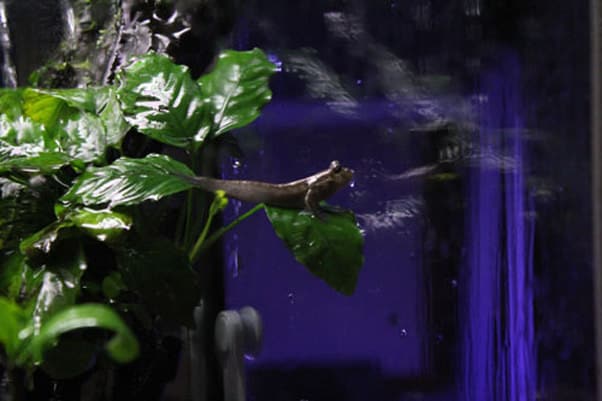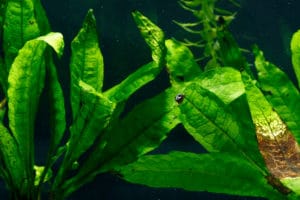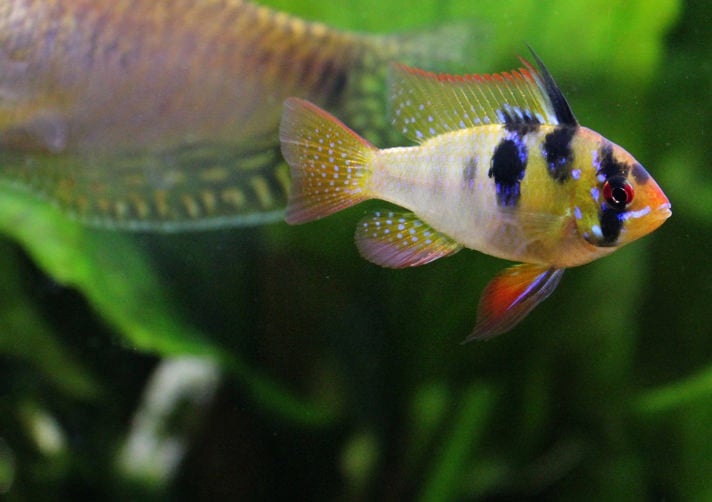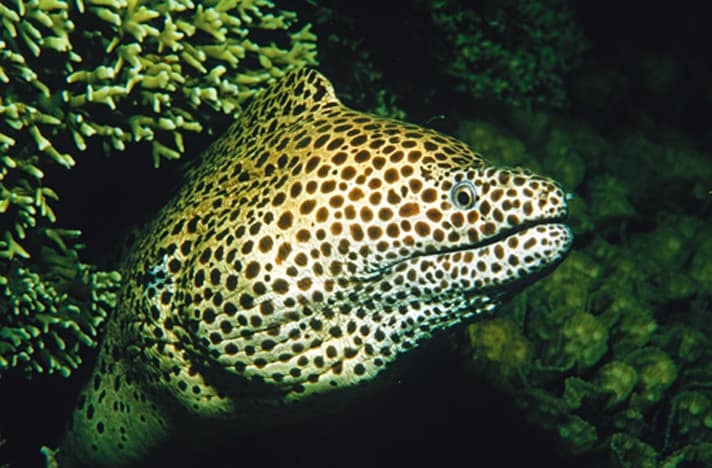Over the years, I have found it is the brackish water tanks that capture the most attention and inquisition of visitors touring my fish room. Examining the aquarium hobby as a whole, brackish water probably offers the greatest potential for future growth.
Brackish water has a salt content greater than freshwater but less than salt water.
The specific gravity (SG) of brackish water ranges from 1.002 to 1.019. Less than 1.002 is considered fresh water while greater than 1.019 is considered sea water. Brackish water is primarily found in estuaries where fresh water, flowing from rivers and streams intermingle with saltwater. Estuary waters are referred to as dynamic areas with their ever changing salt content caused by rainfall (or lack thereof) and daily tides. Species permanently residing in the estuary systems are resilient and more adaptable to constant change than perhaps some of our more sensitive freshwater species.
Who Should Keep Brackish Water Tanks?
I recommend hobbyists wait until they have successfully maintained a 10 gallon freshwater or larger fish aquarium for more than a year. This is primarily because of brackish water’s more complex water chemistry, the additional expense of many brackish water fishes, brackish water fish compatibility and potential size issues.
Full-Grown Size and Requirements Matter
It is always best to fully research the species you desire to keep prior to purchase. Pay particular attention to the specific gravity of their water. Also investigate mature size, diet required and behavior. While some species such as the most unusual Anableps (Four-Eyed Fish) seem enticing, they are actually a poor choice due to their need for at least a 6-foot long aquarium.
To house an adult Anableps in anything smaller is cruel. It is disheartening to read a post on the FishChannel.com forum about a hobbyist who purchased several cute little Figure Eight Pufferfish (Tetraodon biocellatus) from a discount house and wants to know why they are attacking each other in a five-gallon aquarium. A five-gallon tank is not large enough for one Pufferfish and because of potential behavioral issues, is best kept one per tank. To avoid disappointment, always fully research the species and avoid impulse purchases.
Small Brackish Water Set-Up
Given the current trend for nano aquariums, we will look at setting up a small brackish water aquarium ranging from 6 to 20 gallons without using any specialized equipment except a hydrometer for measuring the water’s salt content. Plan well ahead by figuring which fish you would like to keep and then determine if you have a tank and life support equipment to support the species for its entire life. Check to ensure all of the equipment is saltwater safe. If it can be used for saltwater, it is fine for brackish water use. I highly recommend using tank heaters encased by a plastic heater guard. Species such as mudskippers enjoy resting directly on the aquarium’s heater and could become badly burned if not protected from direct contact with the heating element. Contact a locally-owned pet shop for ordering the fish and seek their advice for preparing your tank prior to the order’s arrival. I am a strong believer in the use of live plants. Besides looking great, live plants help maintain good water chemistry and provide shelter and comfort for our fish. Sadly, brackish water has a bad reputation for being hostile to aquatic plants. In reality, many live plants grow quite well in brackish water. Please see the below list of brackish water recommended plants.
Set-up and cycle your small brackish water tank just as you would do for a freshwater aquarium. Mix the salt in a plastic bucket rather than inside the tank. The reason for mixing in a bucket is to ensure all of the salt is dissolved and equally distributed, which allows for accuracy in measuring the salt content of the water. The ‘tornadic’ effect from adding salt to the tank and then trying to mix by swirling is disruptive to the aquascape and in an established aquarium, could be deadly to your fish and plants. Plants need to be slowly acclimatized to brackish water. I think the reason some hobbyists are unsuccessful with live plants in brackish water is because they take plants grown in freshwater and simply dump them in brackish conditions.
A great time to acclimate your plants to brackish water is while your aquarium is in the cycling stage. A large, glass mixing bowl is ideal for acclimatizing because it allows the plants to receive plenty of light and is easy to empty and refill. Premix the water and salt to a slightly brackish level of just SG 1.002 and add the plants. Over a period of about two weeks, gradually increase the salt content to the desired level when conducting water changes. Ensure the plants receive sufficient light and nutrients during the transition. Introduce the plants to the aquarium as soon as the acclimatization is complete.
Most of the plants recommended below are able to thrive with virtually any aquarium lighting system. The only exceptions are the Bacopa species and the red mangrove. Bocopa needs high-intensity lighting and enjoys CO2 injection to ensure lush growth. The red mangrove also needs high intensity lighting. Mangroves cannot survive completely submerged and must have their leaves above the water’s surface.
Small Aquarium Brackish Water Fish Recommendations
1.Bumblebee gobies (Brachygobius) always draw viewing interest. They are exquisitely adorned with vivid black and yellow or orange striping. These fish tend to be a little grumpy so keep only one in a 6 to 10 gallon tank. They need live foods but will readily accept frozen blood worms as a temporary alternative. Provide the tank with a log for them to use as a resting area.
2.Mudskippers (Oxudercinae) are true amphibious fish that live about 90% of their life out of water. They are capable of climbing and must be kept in an aquarium with a tight fitting lid to preclude their escape. They are aggressive toward each other; keep only one per small aquarium. They will eat anything smaller then themselves. Mudskippers must have a large, dry beach area for them to walk and bask in warm lighting.
3.Figure Eight Puffers (Tetraodon biocellatus) are fish with a personality that will become quite attached to you. They can become quite tyrannical toward their own kind or fish with long fins. I’ve found they are best kept alone in 15 to 20 gallons of water.
4.Mollys (Poecila SPP.) are excellent community fish and the shorter finned versions should coexist well with any of the previously listed brackish water fishes in a 20 gallon aquarium. Just watch everyone in the tank for signs of aggression. If noted, remove the aggressor or the other fish because the situation will not get better until one or the other is gone.
Easy to Grow Brackish Water Plants
1.Java fern (Microsorum pteropus) grows best attached to a rock or log. Use cotton thread to gently attach the plant.
2.Anubias is a slow-growing plant that also should be attached to a log or rock. Occasionally, this plant produces a magnificent flower.
3.Java moss (Taxiphyllum barbieri) grows into a thick cluster and is ideal for harboring small fish such as newborn mollies. Java moss is tolerant of weak brackish water with a SG of 1.002 to 1.003.
4.Cryptocoryne wendtii and C. undulate are ideal brackish water plants. They will suffer ‘Crypt melt’ where the leaves seem to melt away if not slowly acclimated to brackish water. Be patient, in good conditions, the plant will rebound if this occurs.
5.Vallisneria is a resilient plant. Given its ability to grow to the water’s surface, plant it along the sides and back of the aquarium.
Brackish water aquariums bridge the gap between the freshwater and saltwater aspects of our hobby. They are not only intriguing but also a wonderful education tool. For experienced aquarists I ask, what are you waiting for? Enjoy your fish!
Read More:
Brackish Tanks
By: Chewy Editorial
Featured Image: Via Stephen G. Noble
Share:










